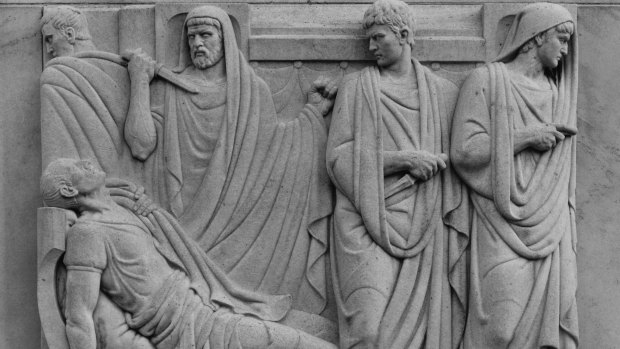
The reverse features two daggers and between them a cap known as a pileus. The daggers stand for Brutus and Cassius and reflect the manner of Caesar’s death, experts say, while the cap is a symbol of liberty that was worn by freed slaves. Overall, the image is meant to celebrate the murder as an act by which Rome was liberated from Caesar’s tyranny. Beneath the symbols is the Latin inscription “EID MAR” designating the Ides of March the fateful day on which the conspirators left Caesar dead on the floor of the Roman Senate.

The bas-relief sculpture of Julius Caesar showing the assassins with their knives turning away as Caesar dies at the Folger Shakespeare Library in Washington.Credit:Folger Shakespeare Library
Historians see irony in the fact that Brutus, who had admonished Caesar before the murder for aggrandising himself by putting his face on Roman coinage, wound up doing the same with his own coins.
Ultimately, the forces who favoured the dead Caesar, led by Mark Antony and others, defeated Brutus and his men in October of 42 BC at the Second Battle of Philippi, and Brutus and Cassius took their own lives.
According to investigators, the coin is first thought to have come to market between 2013 and 2014. Richard Beale, 38, director of London-based auction house Roma Numismatics, put it up for sale on his company’s website and over several years shopped it at coin shows in the United States and Europe before it was sold in October 2020. The $US4.2 million was the most paid for an ancient coin, according to the Numismatic Guaranty Corp.
Loading
Beale is charged with grand larceny in the first degree and several other felonies and was released on his own recognisance. His lawyer, Henry Mazurek, declined to comment on the case.
Among the other Greek antiquities repatriated were figurines of people and animals; marble, silver, bronze and clay vessels; and gold and bronze jewellery. Their total value was put at $US20 million.
In remarks at the ceremony, Konstantinos Konstantinou, Greece’s consul general in New York, said his country has been hit hard by the illicit trading of antiquities and is seeking their return “in every possible way”.
He praised investigators for “striking down the illegal international criminal networks whose activity distorts the identity of peoples, as it cuts off archaeological finds from their context and transforms them from evidence of people’s history into mere works of art”.









 Add Category
Add Category